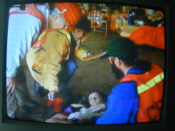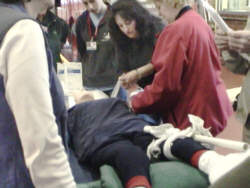 |
Splinting Practice Saturday January 31, 2004 starting at 9 am at Fire Station 5, next to Dewitt Park
|
 |
 |
Splinting Practice Saturday January 31, 2004 starting at 9 am at Fire Station 5, next to Dewitt Park
|
 |
 |
Splinting and general response to injuries with Lt. Kevin Shanders Portland Fire Bureau TRIAGE: then... Then we make a general assessment: A (airway), B (bleeding), C (circulation) Followed by a whole body assessment -- head to toe. Find fractures, internal injuries, external bleeding. Look for signs of shock, head injuries, internal bleeding. Note breathing, pain, rigidity, swelling, discoloration, dislocation, medi-alert bracelets, etc. |
||
 |
|
||
 |
Here we had a virtual amputation. The bleeding would soon be fatal. A tourniquet was necessary. Materials were found in a junk pile in the garage. Rags, pieces of pipe, scraps of wood, pieces of Romex house wiring, etc. All were potential life-savers ("junque"). | ||
| A fractured tibia. Cardboard from the garage was fashioned into a firm splint and fixed into place with masking tape. A similar splint was made for a suspected broken ankle |  . . |
||
 |
|
||
 |
|
||
| A fractured femur: The victim was in great pain. Pulling hard on the ankle put traction on the leg and greatly alleviated the pain...and would soon relieve the tetanus in the leg muscles. A slat in a nearby fence was torn out of place and used for the splint. Several volunteers were recruited to roll the victim up and slide the fence slat under the injured leg--while the leg puller directed the operation to assure fast, precise, coordinated movements. |
|